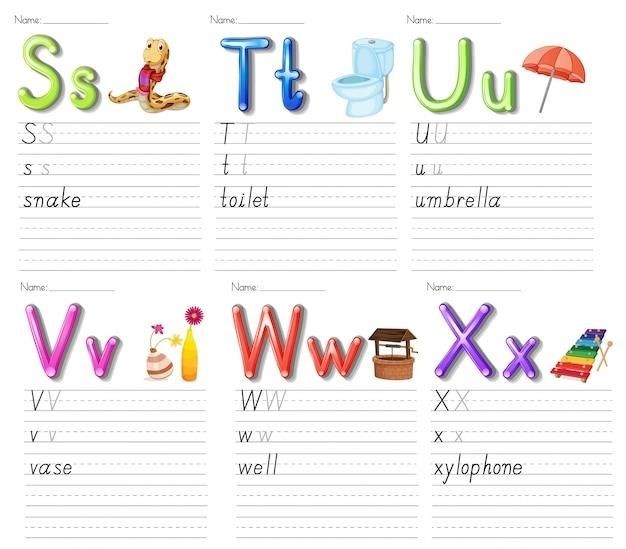
Learning English from A to Z⁚ A Comprehensive Guide
This guide offers a structured path to English fluency, from beginner to advanced levels. Free PDF resources, online courses, and interactive exercises are provided to aid your learning journey. Master grammar, vocabulary, and pronunciation with ease.
Beginner Resources⁚ PDFs and Online Courses
Embark on your English language learning adventure with readily accessible beginner resources. Numerous websites generously offer free downloadable PDF courses tailored for beginners. These PDFs often encompass fundamental grammar rules, essential vocabulary lists, and practical exercises to reinforce your learning. Supplement these PDFs with free online courses. Many platforms provide structured lessons, interactive quizzes, and engaging multimedia content to enhance your comprehension and retention. Look for courses focusing on pronunciation, basic sentence structures, and common conversational phrases. Remember to utilize the readily available online dictionaries and translation tools to aid in understanding unfamiliar words and expressions. These combined resources provide a solid foundation for building your English proficiency. The key is consistent practice and active engagement with the materials.
Essential Vocabulary for Beginners

Building a strong vocabulary foundation is crucial for early English language acquisition. Begin by mastering high-frequency words—the words most commonly used in everyday conversation and writing. Focus on core vocabulary categories such as greetings, introductions, basic verbs (to be, to have, to do), common nouns (people, places, things), and essential adjectives. Utilize flashcards or vocabulary-building apps to memorize new words effectively. Group words thematically to improve retention and create meaningful associations. Practice using these words in simple sentences to reinforce understanding and build fluency. Don’t get bogged down trying to learn every word at once; focus on gradual, consistent progress. Regular review is key to long-term retention. Supplement your learning with resources like illustrated vocabulary lists and interactive online exercises. Remember, consistent effort is the key to building a solid vocabulary base.
Basic Grammar and Sentence Structure
Grasping fundamental English grammar is essential for effective communication. Start with the basics⁚ sentence structure (subject-verb-object), articles (a, an, the), and verb tenses (present simple, past simple, future simple). Understand the roles of nouns, pronouns, adjectives, adverbs, and prepositions. Practice constructing simple sentences and gradually progress to more complex structures. Utilize online grammar exercises and interactive quizzes to reinforce your understanding. Focus on mastering one grammatical concept at a time before moving on to the next. Refer to grammar textbooks or online resources for detailed explanations and examples. Pay attention to sentence punctuation (periods, commas, question marks) to ensure clarity and accuracy. Regular practice is key to solidifying your grammatical foundation. Consistent effort in applying these rules in speaking and writing will accelerate your progress. Don’t be afraid to make mistakes; learning from errors is a crucial part of the process.
Common English Phrases and Idioms
Learning common English phrases and idioms significantly enhances fluency and natural-sounding speech. These expressions often defy literal translation, requiring memorization and contextual understanding. Start with basic greetings and farewells (“Hello,” “Goodbye,” “How are you?”). Progress to everyday phrases like “Please,” “Thank you,” “Excuse me,” and “You’re welcome.” Explore idioms related to time (“kill time,” “in the nick of time”), weather (“raining cats and dogs”), and feelings (“over the moon,” “under the weather”). Utilize flashcards, online resources, or idiom dictionaries for effective memorization. Pay attention to the context in which these phrases are used to grasp their nuanced meanings. Practice incorporating them into your conversations and writing to improve naturalness. Reading English books, watching movies, and listening to native speakers will expose you to numerous idioms in context. Don’t be afraid to ask native speakers for clarification on unfamiliar phrases. Regular review and active use are vital for mastering these essential components of fluent English.
Free Online English Courses for Beginners
Numerous websites offer free online English courses specifically designed for beginners. These platforms provide structured learning paths, often incorporating interactive exercises, quizzes, and progress tracking. Many courses focus on fundamental grammar, vocabulary, and pronunciation. Some popular options include Duolingo, Memrise, and Babbel (though Babbel offers a freemium model). These platforms often utilize gamified learning techniques to maintain engagement and motivation. Look for courses that align with your learning style and pace. Consider factors such as course length, content delivery methods (videos, audio, text), and interactive features. Supplement online courses with additional resources, such as PDF workbooks or language exchange partners, to enhance your learning experience. Remember to set realistic goals and maintain consistency for optimal results. Regular practice, even for short durations, is more effective than infrequent lengthy sessions. Don’t be afraid to explore different platforms to discover the one that best suits your needs and preferences. The key is to find a course that keeps you motivated and engaged in the learning process.
Downloadable PDF Workbooks for Self-Study
Self-study workbooks offer a structured approach to learning English at your own pace. Many free and paid resources are available online, catering to various skill levels. These workbooks often include exercises focusing on grammar, vocabulary, and sentence structure. They typically progress systematically, introducing new concepts gradually. Look for workbooks with clear explanations, plenty of practice exercises, and answer keys to check your progress. The advantage of PDFs is their portability and accessibility; you can access them anytime, anywhere. Consider factors such as the workbook’s focus (e.g., grammar, vocabulary, conversation), its level (beginner, intermediate, advanced), and the inclusion of supplementary materials like audio files or answer keys. Supplementing your studies with other resources, such as online courses or language exchange partners, can further enhance your learning. Remember to schedule regular study time and maintain consistency for effective learning. Choose a workbook that aligns with your learning style and goals. Don’t hesitate to use multiple workbooks to diversify your learning experience.
Interactive Exercises and Quizzes
Interactive exercises and quizzes offer a dynamic way to reinforce your English learning. Numerous websites and apps provide engaging activities that test your comprehension and application of newly acquired knowledge. These interactive tools often adapt to your skill level, providing personalized feedback and targeted practice. They can cover various aspects of the language, including grammar, vocabulary, pronunciation, and reading comprehension. The interactive nature of these exercises keeps you actively involved in the learning process, making it more enjoyable and effective. Many platforms offer progress tracking, allowing you to monitor your improvement over time. Look for platforms that offer a wide variety of exercises, cater to different learning styles, and provide detailed explanations for incorrect answers. The combination of immediate feedback and adaptive learning makes interactive exercises and quizzes a valuable tool for enhancing your English skills. Supplementing your studies with these resources can significantly improve your understanding and retention of grammar rules, vocabulary words, and idiomatic expressions. Consider incorporating interactive exercises and quizzes into your regular study routine for a more engaging and effective learning experience.
Improving Reading Comprehension with Beginner-Friendly Books
Boosting your reading comprehension is crucial for English language acquisition. Start with beginner-friendly books specifically designed for ESL/EFL learners. These books often feature simplified vocabulary and sentence structures, making them easier to understand. Look for books with engaging storylines and relatable characters to maintain your motivation. Don’t be afraid to use a dictionary or online translation tools to look up unfamiliar words, but try to understand the context first before resorting to these aids. Focus on grasping the overall meaning of the text rather than getting bogged down in individual words. Practice reading regularly, even if it’s just for a short period each day. As your comprehension improves, gradually move on to more challenging books. Consider joining a book club or online forum to discuss your reading with others. This can help you understand different perspectives and improve your critical thinking skills. Reading diverse genres, like short stories, novels, and articles, will broaden your vocabulary and expose you to different writing styles. Remember, consistent effort is key to enhancing your reading comprehension and overall English proficiency.
Listening Practice⁚ Podcasts and Audiobooks
Immerse yourself in the English language through listening practice using readily available podcasts and audiobooks. Podcasts offer a diverse range of topics, from news and current events to storytelling and comedy, catering to various interests and skill levels. Start with podcasts designed for English learners, which often feature slower speech and simpler vocabulary. Gradually increase the difficulty as your listening comprehension improves. Audiobooks provide a captivating way to improve listening skills while enjoying engaging stories. Choose audiobooks with accompanying texts to follow along and enhance understanding. Pay attention to pronunciation, intonation, and rhythm to improve your own speaking skills. Don’t be discouraged if you don’t understand everything at first. Focus on key words and phrases, and try to get the overall meaning of the audio. Regular listening practice, even for short periods, will significantly enhance your ability to understand spoken English. Utilize tools like transcriptions or subtitles to aid comprehension, especially in the beginning stages. Experiment with different accents and speaking styles to expand your listening capabilities. Active listening, where you actively engage with the content and try to understand the speaker’s message, is more effective than passive listening.
Advanced Learning Resources⁚ Moving Beyond Beginner Level
Once you’ve established a solid foundation in English, it’s time to explore advanced learning resources to further refine your skills. These resources focus on expanding vocabulary, mastering complex grammar structures, and improving fluency. Consider enrolling in intermediate or advanced online courses, which often include interactive exercises, personalized feedback, and opportunities for communication with other learners. Explore more challenging reading materials, such as novels, newspapers, and academic journals. Focus on understanding nuanced language and complex sentence structures. Engage in more advanced listening exercises, such as watching English-language films and television shows without subtitles, or listening to podcasts on specialized topics. Practice your speaking skills through conversations with native speakers, either in person or online. Utilize online language exchange platforms or find a language partner to engage in regular conversations. Consider pursuing a certification exam, such as the TOEFL or IELTS, to assess your proficiency and demonstrate your language skills to potential employers or educational institutions. Continuously challenge yourself with new vocabulary and grammar concepts. Explore different English dialects and accents to broaden your understanding of the language’s diversity. Don’t hesitate to seek out advanced grammar textbooks and workbooks to refine your understanding of complex grammatical structures.
Maintaining Motivation and Consistency in Learning
Consistency is key to successful language acquisition. Set realistic, achievable goals to avoid feeling overwhelmed. Start with short, daily study sessions rather than infrequent, lengthy ones. Find a learning style that suits you best – whether it’s through interactive apps, engaging videos, or traditional textbooks. Incorporate fun activities into your learning routine to prevent burnout. Watch English-language movies or TV shows, listen to podcasts, or read books in English for enjoyment. Join online communities or forums to connect with other learners and share your progress. Celebrate your achievements, no matter how small, to stay positive and motivated. Don’t be afraid to make mistakes; they are a natural part of the learning process. Embrace challenges and view them as opportunities for growth. Remember your “why” – what motivates you to learn English? Keep this in mind during challenging times to stay focused on your ultimate goal. Reward yourself for reaching milestones, whether it’s a small treat or a larger celebration. Find a language partner or tutor for regular conversation practice. This provides accountability and a supportive environment for learning. Regularly review previously learned material to reinforce your knowledge and prevent forgetting. Utilize spaced repetition techniques to optimize memory retention. Track your progress to visualize your achievements and maintain momentum.